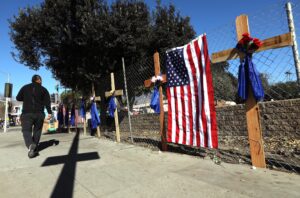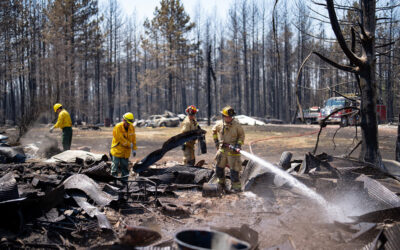
A pedestrian walks past a makeshift memorial to the victims of the Eaton fire at the corner of Lake Avenue and East Villa Street in Pasadena, California, on Jan. 15, 2025. (Genaro Molina/Los Angeles Times/TNS)
LOS ANGELES — As California struggles to defend itself against increasingly destructive urban wildfires, recent fire deaths in Altadena highlight what researchers say is a growing trend in victim demographics.
Up until about the last decade, California wildfires have traditionally affected higher income white households, with deaths skewing toward seniors and men. More recently however, wildfires are increasingly touching more diverse communities as fires grow in intensity and extend into densely populated areas, according to researchers.
Of the 17 people killed by the Eaton fire, more than 70% were Black and 64% were women. More typically however, those killed by the fire had a median age of 77 and at least a third of them suffered impairments that could affect their mobility, according to a Los Angeles Times analysis.
A 2023 study of California wildfires conducted by U.S. Forest Service researchers found that “new fire regimes are increasingly affecting more urban census tracts statewide, meaning greater numbers and more diverse groups of people are being and possibly will be affected by wildfires.” These changes, authors wrote, meant that more Latino, Asian and Black Californians were being impacted by wildfire than ever before.
The trend, they say, could become even more pronounced in the future, and could have potentially serious consequences for wildfire readiness.
” … The increasing occurrence of wildfires in urban areas suggests a need for increased outreach to residents of more urbanized neighborhoods and communities that have never experienced wildfires,” the study authors wrote.
“Even in those that have historically been sporadically affected by wildfire, their residents are likely to have lower perceptions of risk, believing that wildfires will not occur in their neighborhoods. Similarly, they are likely to be less prepared for wildfires, such as having a ‘go bag’ or completing home mitigation measures.”
In the case of the Eaton fire, emergency management officials have been harshly criticized for significant delays in the issuing of electronic evacuation orders — delays that some say cost residents their lives.
Eastern Altadena received a warning text and evacuation orders within about the first hour after the fire began on the evening of Jan. 7. The western boundary for the alerts, North Lake Avenue, would come to be a fateful dividing line: Altadena homes east of North Lake received evacuation orders at least eight hours before homes on the west side.
All 17 Eaton fire deaths happened west of North Lake avenue, in areas which never received evacuation warnings and received evacuation orders hours after homes had already been reported to be on fire, a Times investigation found.
Many residents of western Altadena — which was shaped by discriminatory lending practices in the 1960s and ‘70s and has become known for its strong Black community— told the Times they felt forgotten. North Lake Avenue was the boundary line for these redlining efforts, and racial gaps have persisted: Altadena’s east side is whiter and incomes are higher than those of the west side, per Census data.
Nearly a third of those killed in the Eaton fire suffered some form of disability. Among them was 56-year-old Carolyn Burns.
Burns, who used a wheelchair and walker to get around, lived with her 76-year-old mother.
Burns’ mother, who is also named Carolyn, told The Times that another of her daughters called the Los Angeles County Fire Department around 10 or 11 on the night of the fire to ask about conditions in their neighborhood. They were reportedly told that the street was safe at the moment and if they needed to be evacuated, someone would knock on the door.
At around 3:30 a.m. the mother woke to the sound of a neighbor banging on a window and yelling that the house was on fire. She jumped out of bed and saw flames in her kitchen. She managed to escape, but her daughter did not.
“I don’t think they did their jobs because they didn’t get over there in time or knock on our doors,” the mother told The Times. “I think it was too late. Even if they needed to get her out of there, they didn’t have enough time. We’re very angry inside and we’ll never be the same.”
The Los Angeles County Fire Department declined to comment on the evacuation orders or Burns’ death. In a statement, the agency said the L.A. County Board of Supervisors has opened an investigation into the evacuations and emergency notifications. Reports will be due back to the board every 90 days and shared with the public.
The fire department “acknowledges the immense loss and challenges faced by our communities during the wildfires and remain deeply committed to supporting those affected,” according to the statement.
Mark Ghilarducci, who served as the director of the California Governor’s Office of Emergency Services for more than a decade, said it doesn’t “sound normal” if disabled residents were indeed left to evacuate on their own.
“There’s generally an understanding of individuals who have access and functional needs where they can be supported,” he said. “Sometimes the 911 centers know that they exist. A lot of the time, it’s law enforcement going door to door to ensure that people are getting out and and being notified.”
Senior citizens tend to be the ones who die in wildfires, he said, because they aren’t as attuned with social media, could be more limited in their mobility or rely on others to drive them around.
“We need to figure out exactly what happened, why were decisions made the way they were, and if it was a failure in technology, we need to identify that as well and figure out, how do we address that?” Ghilarducci said. “It isn’t normal. We want people to get out of harm’s way.”
Fires with large death tolls are relatively rare in California history but have been growing in frequency over the last 10 years, according to Michele Steinberg, a spokesperson for wildfire division of the National Fire Protection Assn.
In all major incidents — including the Eaton and Palisades fires — seniors are the most vulnerable.
Steinberg said older residents may have difficulty evacuating, due to potential mobility issues, or they may simply refuse to leave.
In some of the past cases Steinberg has reviewed, those fatalities who were younger — in their 50s or 60s — died while trying to help others.
“You’re trying to save pets, save people, take care of people,” Steinberg said. “You yourself might be able and willing and ready, but you have someone else to look after.”
Ultimately, life or death can come down to how quickly a person can react to a fast-moving and unexpected situation, she said. “People aren’t just independently jumping in their car wide awake — it’s chaos.”
In Altadena, where the fire spread in the “middle of the night,” residents likely had even less warning, Steinberg said, with the speed of the fire and possible issues with alerts making the situation more deadly.
Among the seniors killed in the Eaton fire were Dalyce “DeDe” Curry, 95, and Erliene Kelley, 83.
Curry was home alone on the night of the fire, while her granddaughter, Dalyce Kelley, was caring for a sick relative and checking in on her grandmother via text.
Kelley had fallen asleep at her home. At 6:38 a.m., she woke up and wrote to an Altadena neighborhood group chat: “My grandmother is still there. We got home around midnight. Have evacuation orders been implemented? … if they evacuate you all, I’ll come immediately, just please grab her.”
“Every one was evacuated at 3:30,” a neighbor responded.
“Omg,” Kelley replied. “Getting dressed now. Her phone is going straight to voicemail.”
She rushed to her car and raced to her grandmother’s house but was stopped at a police barricade. Kelley gave a police officer her grandmother’s address and asked if he could check on her. The officer called Kelley later, telling her that Curry’s home had burned down.
The Los Angeles Medical Examiner pronounced Curry dead on Jan. 11 and notified her family that her remains had been found on her property, according to Kelley.
One of Curry’s neighbors, Ana Morales, 34, faults officials for failing to warn residents earlier. She said she and her husband decided not to wait for an official evacuation order and fled their home around 9 p.m.
“I don’t think there was enough notice for everybody,” Morales told The Times. “We were going off of our intuition and fear. They should’ve evacuated everybody when we left, told us to pack up everything we need and to leave. But nothing.”
Briana Navarro, who lost her grandmother Erliene Kelley in the fire, agreed. She said her said her grandmother and others could have been saved with earlier notice from officials.
“A lot of the lives that were lost were either elderly or disabled, which is unfortunate because they’re one of the vulnerable groups that need the most assistance from family or their support system,” she said. “I think with a notice it would have given enough time for some of us to go help our family members.”
——-
Times staff writer Ruben Vives contributed to this report.
___
©2025 Los Angeles Times. Visit at latimes.com. Distributed by Tribune Content Agency, LLC.




